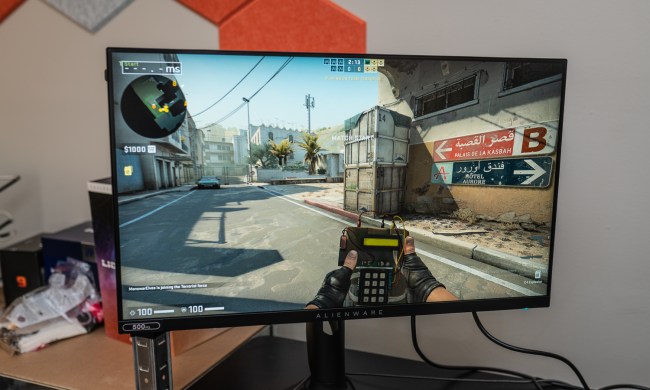AMD announced the next version of FidelityFX Super Resolution (FSR) not too long ago and the company shed more light on how it works on a technical level at GDC 2022.
FSR 1.0 wasn’t perfect, and the new version looks to improve image quality while sticking to the values that made FSR stand out in the first place. Here’s what we learned about FSR 2.0 at GDC 2022, and how it might impact your PC games in the future.
FSR 2.0 quality modes and support

Before getting into the technical details, AMD revealed a few key aspects of FSR 2.0: Its various quality modes and the hardware it will work on. Like FSR 1.0, the new version works across graphics cards, regardless of if they’re from AMD or Nvidia. And FSR 2.0 is open source, so any developer can access it on AMD’s GPUOpen platform.
As for the quality modes, here’s how they shake out:
| Scaling factor | Input resolution | Output resolution | |
| Quality | 67% of screen resolution, 1.5x scaling | 1280 x 720
2560 x 1440 |
1920 x 1080
3840 x 2160 |
| Balanced | 59% of screen resolution, 1.7x scaling | 1129 x 635
2259 x 1270 |
1920 x 1080
3840 x 2160 |
| Performance | 50% of screen resolution, 2x scaling | 960 x 540
1920 x 1080 |
1920 x 1080
3840 x 2160 |
The Ultra Quality mode from FSR 1.0 is gone, and instead, AMD is going with three simple quality modes. There’s an optional Ultra Performance mode for developers, though it won’t be available in every FSR 2.0 release.
For hardware support, AMD has a list of optimized recommendations. For AMD, the lowest option is the RX 590 and for Nvidia, the lowest option is a GTX 1070. You can use FSR 2.0 on less powerful hardware, but AMD says it may not provide an optimal experience.
Console fans have something to get excited about, though: Xbox support. FSR 1.0 supported Xbox, but we didn’t hear much about the tech on Microsoft’s console. Registered Xbox developers can now access FSR 2.0 from AMD free of charge, so hopefully, we’ll see it more in console games.
How FSR 2.0 works

The most important thing you need to know about FSR 2.0 is that it’s not an update to FSR 1.0. It’s something completely new. According to AMD, it was important to build FSR 2.0 from the ground-up due to a big limitation with FSR 1.0: Anti-aliasing.
FSR 1.0 requires high-quality anti-aliasing from the source image. The problem is that a lot of games don’t have high-quality anti-aliasing, leading to much lower image quality in certain titles. That’s likely why FSR looks so much worse in a game like Deathloop than it does in Godfall.
FSR 2.0 doesn’t require anti-aliasing. It takes three inputs from the full resolution: Color, depth, and motion. These inputs can have aliasing, and that’s fine. FSR 2.0 will produce a final frame based on these inputs with anti-aliasing, which should hopefully add more consistency to games that support FSR and increase image quality.
Motion and depth inputs should increase image quality, as well. These are two key factors when it comes to the excellent image quality from Nvidia’s Deep Learning Super Sampling (DLSS).
FSR 2.0 works similarly to DLSS but with one major difference: It doesn’t use machine learning. It appears, based on what we know right now, that FSR 2.0 is like DLSS on a technical level, just with the dedicated hardware and machine learning bits ripped out.

Instead, FSR 2.0 continues to use the Lanczos algorithm, which it used on FSR 1.0. DLSS has excellent image quality, but it’s not clear if that’s due to the machine learning aspect or Nvidia’s approach to upscaling. If the approach makes the difference, FSR 2.0 could finally go toe-to-toe with Nvidia’s flagship feature.
Dealing with artifacts
Like DLSS, FSR 2.0 uses temporal (time-based) information. The problem is that temporal data can cause a wide range of visual artifacts. AMD is addressing those artifacts with FSR 2.0.

First, ghosting. Because FSR 2.0 uses previous frames, there’s a chance that an object will smear on screen, as the upscaling gets confused about where the object is. This is a problem with DLSS, as well. FSR 2.0 uses the depth from the current and previous frames to create a disocclusion mask — essentially an overlay that shows what’s moving from one frame to another.
Then FSR corrects the problem by using a threshold. If the movement is outside the threshold, FSR 2.0 automatically kicks in and corrects the ghosting.
Another major issue with FSR 1.0 was shimmering. This happens as the upscaler tries to gather new data on thin objects — you can see pixels jump back and forth. AMD is solving this issue by locking some parts of a scene. If you stare at a field of grass, for example, the pixels of grass may be locked to avoid this shimmering.
In due time
FSR 2.0 won’t be here until around the summer, so we won’t know how it holds up until it’s here. The insights AMD offered at GDC are promising, though. FSR 2.0 looks to be a much more ambitious release, one that can go toe-to-toe with Nvidia on image quality while maintaining the open-source nature of the original version.




